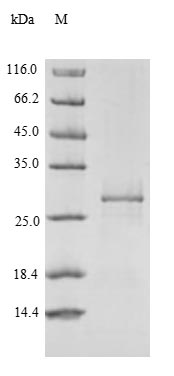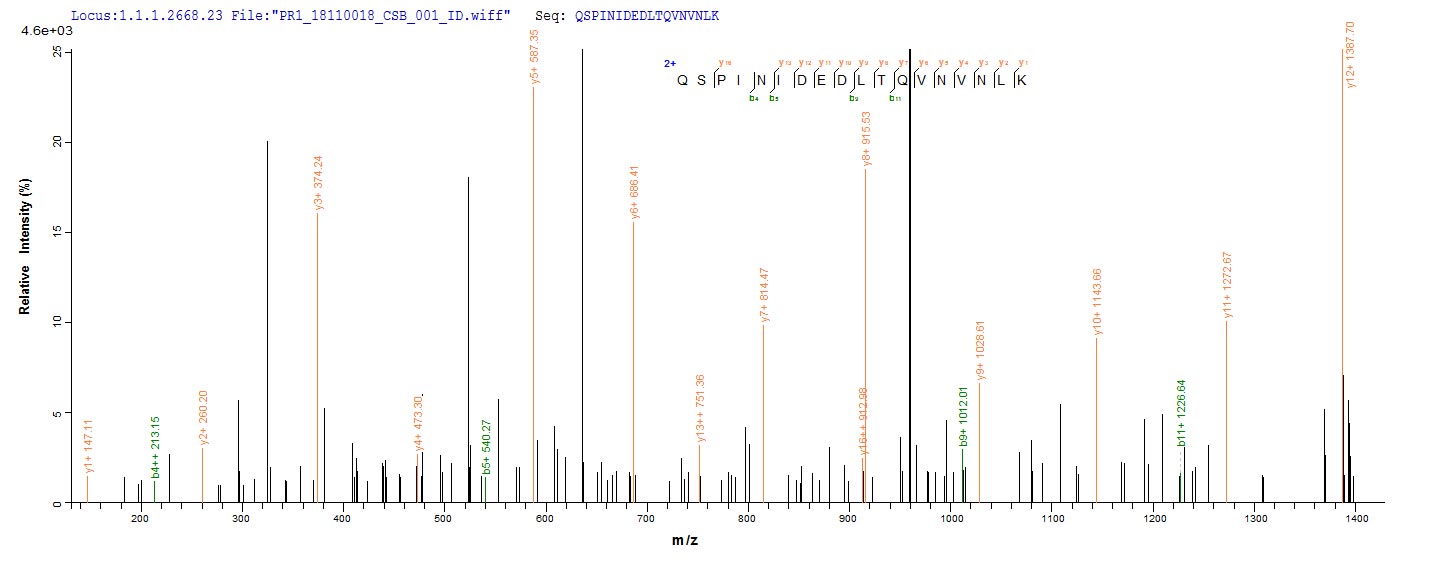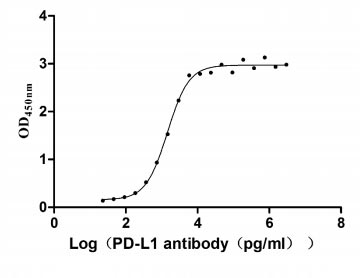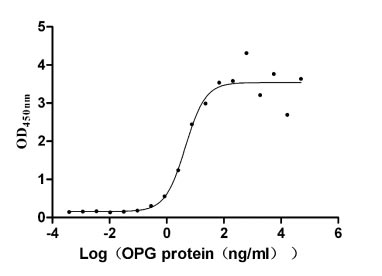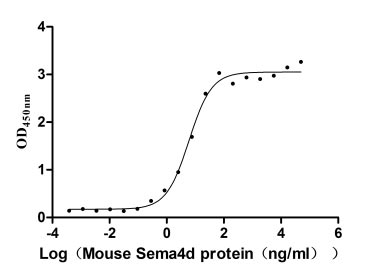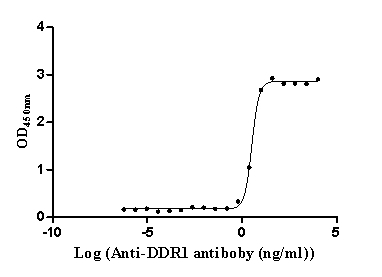-
货号:CSB-YP019068HU
-
规格:¥1500
-
图片:
-
(Tris-Glycine gel) Discontinuous SDS-PAGE (reduced) with 5% enrichment gel and 15% separation gel.
-
Based on the SEQUEST from database of Yeast host and target protein, the LC-MS/MS Analysis result of CSB-YP019068HU could indicate that this peptide derived from Yeast-expressed Homo sapiens (Human) PTPRZ1.
-
Based on the SEQUEST from database of Yeast host and target protein, the LC-MS/MS Analysis result of CSB-YP019068HU could indicate that this peptide derived from Yeast-expressed Homo sapiens (Human) PTPRZ1.
-
-
其他:
产品详情
-
纯度:Greater than 90% as determined by SDS-PAGE.
-
基因名:PTPRZ1
-
Uniprot No.:
-
别名:3F8 chondroitin sulfate proteoglycan; 3H1 keratan sulfate proteoglycan; HPTPZ; HPTPzeta; Phosphacan; Protein tyrosine phosphatase receptor type Z polypeptide 2; Protein tyrosine phosphatase, receptor type, Z polypeptide 1; Protein tyrosine phosphatase, receptor type, zeta polypeptide 1; Protein-tyrosine phosphatase receptor type Z polypeptide 1; Protein-tyrosine phosphatase receptor type Z polypeptide 2; PTP-ZETA; PTP18; PTPRZ; PTPRZ_HUMAN; Ptprz1; PTPZ; R PTP zeta 2; R-PTP-zeta; R-PTP-zeta-2; Receptor type tyrosine phosphatase beta/zeta; Receptor-type tyrosine-protein phosphatase zeta; RPTP-BETA; RPTPB; RPTPbeta
-
种属:Homo sapiens (Human)
-
蛋白长度:Partial
-
来源:Yeast
-
分子量:32.1 kDa
-
表达区域:36-300aa
-
氨基酸序列IGWSYTGALNQKNWGKKYPTCNSPKQSPINIDEDLTQVNVNLKKLKFQGWDKTSLENTFIHNTGKTVEINLTNDYRVSGGVSEMVFKASKITFHWGKCNMSSDGSEHSLEGQKFPLEMQIYCFDADRFSSFEEAVKGKGKLRALSILFEVGTEENLDFKAIIDGVESVSRFGKQAALDPFILLNLLPNSTDKYYIYNGSLTSPPCTDTVDWIVFKDTVSISESQLAVFCEVLTMQQSGYVMLMDYLQNNFREQQYKFSRQVFSSY
Note: The complete sequence including tag sequence, target protein sequence and linker sequence could be provided upon request. -
蛋白标签:N-terminal 6xHis-tagged
-
产品提供形式:Liquid or Lyophilized powder
Note: We will preferentially ship the format that we have in stock, however, if you have any special requirement for the format, please remark your requirement when placing the order, we will prepare according to your demand. -
缓冲液:Tris-based buffer,50% glycerol
-
储存条件:Store at -20°C/-80°C upon receipt, aliquoting is necessary for mutiple use. Avoid repeated freeze-thaw cycles.
-
保质期:The shelf life is related to many factors, storage state, buffer ingredients, storage temperature and the stability of the protein itself.
Generally, the shelf life of liquid form is 6 months at -20°C/-80°C. The shelf life of lyophilized form is 12 months at -20°C/-80°C. -
货期:3-7 business days
-
注意事项:Repeated freezing and thawing is not recommended. Store working aliquots at 4°C for up to one week.
-
产品描述:
The gene fragment corresponding to the 36-300aa of the human PTPRZ1 protein was synthesized, with appropriate restriction sites suitable for in-frame cloning into an expression vector, with N-terminal 6xHis tag. The yeast was transfected with the expression vector, and the clone was expressed upon certain induction. After the induced cell centrifugation, the recombinant protein was purified from the cell extract and presented as N-terminal 6xHis-tagged fusion. This recombinant human PTPRZ1 protein's purity is greater than 90% assayed by SDS-PAGE. The PTPRZ1 protein ran to a band of about 28 kDa molecular weight on the gel.
PTPRZ1, as a member of the PTPR family, is a single-pass type I membrane protein with two cytoplasmic tyrosine phosphatase domains (D1 and D2), an alpha-carbonic anhydrase domain (CA), chondroitin sulfate proteoglycans (CS-PGs) and a fibronectin type-III domain (FNIII). Expression of PTPRZ1 restricted to the central nervous system (CNS), and it may be involved in the regulation of specific developmental processes in the CNS. Diseases associated with PTPRZ1 include generalized epilepsy with febrile seizures plus, Type 1 and oligodendroglioma. Among its related pathways are PAK pathway and spinal cord injury. It has been found that PTPRZ1 is highly expressed in SCLC cell lines and specifically exists in human NET tissues. PTPRZ1 also interacts with its ligand pleiotrophin (PTN), which is a secreted growth factor involved in angiogenesis and tumor growth.
-
Datasheet & COA:Please contact us to get it.
引用文献
相关产品
靶点详情
-
功能:Protein tyrosine phosphatase that negatively regulates oligodendrocyte precursor proliferation in the embryonic spinal cord. Required for normal differentiation of the precursor cells into mature, fully myelinating oligodendrocytes. May play a role in protecting oligondendrocytes against apoptosis. May play a role in the establishment of contextual memory, probably via the dephosphorylation of proteins that are part of important signaling cascades.
-
基因功能参考文献:
- s characterized exosomes from GBM cells harbouring and not harbouring PTPRZ1-MET fusion (ZM fusion). PMID: 28504721
- PTPRZ1 is affected in a contiguous gene deletion syndrome PMID: 23570448
- Confirm contribution of PTPRZ1, and especially PTPRQ, in CRC carcinogenesis and demonstrated that PTPRQ expression is correlated with KRAS mutation. PMID: 26851024
- Data indicate that enhanced MET oncoprotein RNA expression by fusion with receptor-type tyrosine-protein phosphatase zeta (PTPRZ1). PMID: 25935522
- Data indicate that the fusion arose from translocation events involving introns 3 or 8 of protein tyrosine phosphatase, receptor-type, Z polypeptide 1 (PTPRZ1) and intron 1 of hepatocyte growth factor receptor MET. PMID: 25135958
- Distinct domains of PTPRZ-B are differentially required for migration and proliferation of glioma cells, respectively. PMID: 25238264
- Protein tyrosine phosphatase zeta enhances proliferation by increasing beta-catenin nuclear expression in VHL-inactive human renal cell carcinoma cells. PMID: 23588815
- Data suggest that CSF-1R-independent actions of IL-34 via receptor-type protein-tyrosine phosphatase zeta (PTP-zeta) might be considered in evaluating IL-34 roles in development and disease. PMID: 23744080
- PTPRZ1 was highly expressed in human neuroendocrine tumor tissues and PTPRZ1 is an oncogenic tyrosine phosphatase in small-cell lung carcinoma. PMID: 23170925
- Receptor-type Protein tyrosine phosphatase beta regulates met phosphorylation and function in head and neck squamous cell carcinoma. PMID: 23226095
- Studies indicate that RPTPzeta is an RPTP for which a link between ligand-dependent dimerization and inhibition of the intracellular tyrosine phosphatase activity has been clearly established. PMID: 22682003
- Enhanced RPTPbeta/zeta signaling can contribute to schizophrenia phenotypes and support both construct and face validity for PTPRZ1-transgenic mice as a model for multiple schizophrenia phenotypes. PMID: 22832403
- Loss of RPTPZ promotes prostate cancer metastasi. PMID: 23060448
- The results of this study suggested that pleiotrophin inhibition of PTPRZ1 contributes to the homeostatic self-renewal of OPCs and that this process is mediated by the tonic activation of beta-catenin/TCF-dependent transcription. PMID: 23100427
- report the cocrystal structure of the carbonic anhydrase-like domain of PTPRZ bound to tandem Ig repeats of CNTN1 and binding assays to show that PTPRZ binds specifically to CNTN1 expressed at the surface of oligodendrocyte precursor cells PMID: 21969550
- molecular basis for the substrate recognition of Ptprz. PMID: 21890632
- RPTP-beta is a key regulator of Met function. PMID: 21454675
- preferential activation of PTPRZ1 by HIF-2 results at least in part from cooperative binding of HIF-2 and ELK1 to nearby sites on the PTPRZ1 promoter region PMID: 20224786
- PTPRZ1 has a role in oligodendrocyte survival and in recovery from demyelinating disease PMID: 12355066
- RPTPzeta has a novel role in regulating glioblastoma cell motility PMID: 14555979
- In AZ-521 cells, which mainly express RPTPbeta, VacA, after binding to RPTPbeta in non-lipid raft microdomains on the cell surface, is localized with RPTPbeta in lipid rafts in a temperature- and VacA concentration-dependent process. PMID: 17030583
- Midkine, pleiotrophin (PTN), and their receptors syndecan-3 and receptor protein tyrosine phosphatase beta/zeta, were highly expressed in the striatum during developmen PMID: 17368428
- the PTN/RPTPbeta/zeta signaling pathway may be constitutively activated and potentially function to constitutively activate ALK in human breast cancer PMID: 17706593
- the effect of the shorter basic peptide P(122-131) on DU145 cells, which express HARP and its receptor RPTPB, suggested interference, under anchorage-independent conditions, of P(122-131) with a HARP autocrine loop in an RPTPB -dependent fashion. PMID: 17727841
- Pleiotrophin receptor (PTPRZ1) is expressed in embryonic stem cells and mediates important signals for survival, proliferation, and maintenance of pluripotency state. PMID: 17823238
- results from the immunohistochemical analyses of rPTPbeta/zeta expression should prompt further evaluation of this protein as a novel oligodendroglioma marker. PMID: 18003890
- PTPRZ1 is unlikely to be related to the development of schizophrenia in the Japanese population PMID: 18186075
- the cleavage sites in the extracellular juxtamembrane region of Ptprz by tumor necrosis factor-alpha converting enzyme and matrix metalloproteinase 9. PMID: 18713734
- GnT-Vb-mediated glycosylation of RPTPbeta promotes galectin-1 binding and RPTPbeta levels of retention on the cell surface. PMID: 18838383
- these data suggest that alpha(v)beta(3) is a key molecule that determines the stimulatory or inhibitory effect of pleiotrophin on cell migration. PMID: 19141530
- phosphacan was present in the evolving astroglial scar after human traumatic spinal cord injury, and, therefore, might play an important role in the blockade of successful CNS regeneration. PMID: 19604403
显示更多
收起更多
-
亚细胞定位:[Isoform 1]: Cell membrane; Single-pass type I membrane protein. Secreted.; [Isoform 2]: Secreted.
-
蛋白家族:Protein-tyrosine phosphatase family, Receptor class 5 subfamily
-
组织特异性:Specifically expressed in the central nervous system, where it is localized in the Purkinje cell layer of the cerebellum, the dentate gyrus, and the subependymal layer of the anterior horn of the lateral ventricle. Developmentally regulated in the brain.
-
数据库链接:
HGNC: 9685
OMIM: 176891
KEGG: hsa:5803
STRING: 9606.ENSP00000377047
UniGene: Hs.489824
Most popular with customers
-
Recombinant Human Programmed cell death 1 ligand 1 (CD274), partial (Active)
Express system: Mammalian cell
Species: Homo sapiens (Human)
-
Recombinant Human Tumor necrosis factor receptor superfamily member 11B (TNFRSF11B) (Active)
Express system: Mammalian cell
Species: Homo sapiens (Human)
-
Recombinant Mouse Semaphorin-4D (Sema4d), partial (Active)
Express system: Mammalian cell
Species: Mus musculus (Mouse)
-
Recombinant Human Insulin growth factor-like family member 1 (IGFL1) (Active)
Express system: Mammalian cell
Species: Homo sapiens (Human)
-
Recombinant Human IGF-like family receptor 1 (IGFLR1), partial (Active)
Express system: Mammalian cell
Species: Homo sapiens (Human)
-
Recombinant Human Epithelial discoidin domain-containing receptor 1 (DDR1), partial (Active)
Express system: Mammalian cell
Species: Homo sapiens (Human)
-
Recombinant Human CUB domain-containing protein 1 (CDCP1), partial (Active)
Express system: Mammalian cell
Species: Homo sapiens (Human)
-
Recombinant Human Oncostatin-M (OSM), partial (Active)
Express system: Mammalian cell
Species: Homo sapiens (Human)

